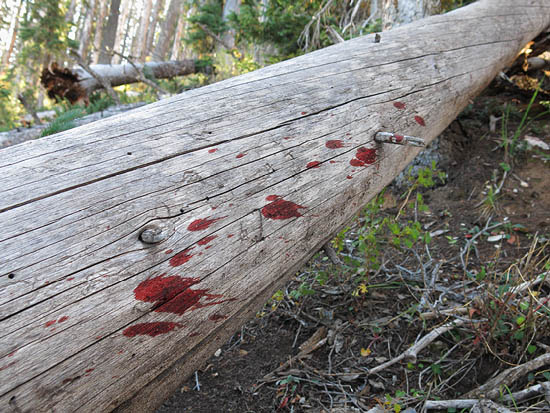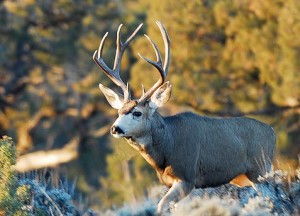Blood-Trailing Wounded Animals
Sooner or later every bowhunter will have to deal with a poorly hit animal. An ethical hunter must do whatever it takes to follow-up and recover wounded game. Arrow-hit deer rarely go down immediately, so every hunter needs to understand the basics of blood-trailing. In this article we’ll look at some tips and tactics for tracking wounded deer.
An arrow kills a deer differently than a bullet. Bullets rely more on shock and devastating tissue damage, whereas an arrow kills either by massive blood loss due to arterial damage, or through asphyxiation by deflating the lungs.
A third and much less effective method is septic shock. Septic shock, or blood poisoning, is the result of gut-shot animals slowly dying as their stomach contents and bacteria gradually overwhelm the blood stream. Basically the deer dies from a full-body infection over the course of several hours or even days. Oftentimes the animal is lost because it bleeds very little and covers lots of ground.
Give it some Time
Unless the animal goes down within sight, you need to give it some time to die. Even if you’re confident in a heart or lung shot, you should still wait a half hour minimum before tracking.
If you suspect a gut shot, wait at least two or three hours before tracking, and then proceed very cautiously while glassing ahead. If it’s very cold out, it would be probably be fine to leave it over night.
Whatever you do, don’t go barreling in on the deer. Arrow-shot deer sometimes don’t realize they’ve been hit and will only run a short distance before bedding down. You do not want to bump the animal, but if you are able to stalk close enough, try to get a second arrow in the animal to put it out of its misery.
Weather Factors
You do not want to leave a mortally hit animal sitting for several hours in hot weather. Even a marginally hit animal will slow down and stiffen up within a few hours, so possibly bumping him is still better than letting the whole animal spoil overnight. Just use your best judgment based on the conditions you’re dealing with.
In rainy or snowy weather you should hasten your tracking job. Water will quickly wash away any blood, and snow can cover it up.
Where to Start
Immediately following your shot, mark the spot you shot from with orange tape, and then mark the place where the deer was standing. Next, see if you can find your arrow and inspect it carefully. Bright red, bubbly blood is usually lungs. Any green smears or foul smells indicates stomach, and very dark blood can anything from muscle to heart or liver. Heart shots are obvious as they tend to bleed profusely.
Once you’ve determined the quality of your hit, try to pick up the blood trail. The secret to successful animal recovery is moving slowly, as if you are still-hunting. Make very little noise and glass ahead frequently. If at all possible, move with a favorable wind.
While blood-tracking, plan on following both blood and tracks. Sometimes a deer will bleed completely internally, in which case you will rely more on tracking than blood-trailing. Fortunately running deer tend to leave very deep and obvious tracks accompanied by torn-up ground.
Inevitably you’ll get stuck with a very sparse or problematic blood-trailing job. If the blood trail is very light, you should follow these guidelines:
Tips for Following Sparse Blood Trails
- Don’t step on or disturb any blood specks or tracks. You may have to return back to these clues later on.
- Continually mark the blood trail as you go, either with a GPS, orange tape, or toilet paper. By keeping track of the trail you may be able to determine the general direction the buck is headed.
- In places where you are unable to see tracks, you can still determine the direction of travel by reading blood splashes: they always splash forward. If the blood trail is sparse, you can tell the direction of travel by which side of the grass the blood is on.
- In the evening you might have to track faster. It’s much harder to trail a buck in the dark, but if you must just be sure to have a very bright flashlight. This will not only help you locate more sign, but will light up the deer’s glowing eyes far ahead so you don’t bump him further.
- If the trail runs cold, consider enlisting the help of a blood-trailing dog. Dogs trained to follow blood trails are becoming a popular method for recovering wounded game. Once the deer goes down, it won’t last long sitting in the field, so consider getting the dog handlers contact information before the hunt.
- If you lose the trail completely, you will have to employ a “grid-search” beginning where the last sign disappeared. At this point you should be able to “guestimate” the deer’s general direction of travel. Use your GPS to keep track of everywhere you’ve been and where you haven’t. Because you are now on a timer, grid-searching should be done with as many helpers as possible.
Final Thoughts
Contrary to popular belief, wounded animals don’t go directly to water, nor do they run directly downhill. Rather their first inclination is to put as much distance between you and them as possible. Given enough time the animal will eventually seek out water, but don’t count on it.
As for direction of travel, I’ve seen mortally wounded animals run uphill or downhill. But more often they side-hill or slant downhill over very long distances. Once again, every shot situation is different, so use your best judgment.
On rare occasion a deer that seems mortally hit will escape and make a full recovery. This happens a lot with high hits in “no-man’s-land,” as it’s sometimes called. Other times the arrow may have only contacted muscle tissue. Either way, you’ll likely never catch up to the animal. That doesn’t mean you shouldn’t try; it just means there are times when you must throw in the towel. Only experience can tell you how to proceed.



